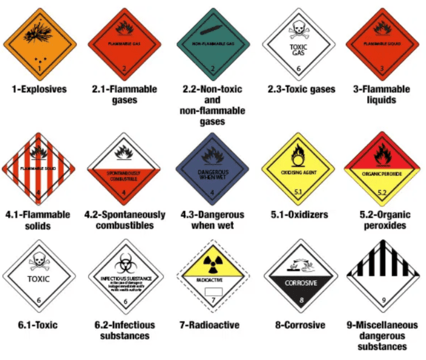International shipping is already complicated, but introducing hazardous and dangerous cargo into the equation requires even more work.
But for good reason. Correctly shipping hazardous cargo is extremely important. Primarily because of the potential for harm to handlers on-route, but also because mistakes carry greater more severe penalties and fines than regular cargo.
Here, WTA explains how hazardous goods can be shipped at sea. Focusing on the International Maritime Dangerous Goods (IMDG) code in detail and the information that you need to be aware of for smooth and safe shipping.
If you are interested in shipping dangerous goods via air freight, then please check out our article here, which covers IATA's Dangerous Goods Regulation in detail.
Benefits of shipping dangerous goods by sea
The principle benefit of shipping hazardous cargo at sea is cost. Compared to air freight, this will be the cheaper option as carriers can get far more goods onto a single boat.
It is also the more environmentally friendly method, as the carbon emissions per container are less. Progress is also being made using zero-emission vessels and introducing green shipping routes.
Of course ocean freight also offers the most flexibility in terms of what goods can be sent, as some hazardous cargo isn't allowed on planes. Furthermore, as the maritime code strengthens year-on-year, shipping dangerous goods at sea is becoming safer all the time. Handlers are very experienced in dealing with this kind of cargo as it is a trusted method of transport.
Classification of Dangerous Goods
To move dangerous goods at sea you first need to establish what class they fall into. This is so everyone moving the goods can establish what dangers are presented by the goods and the steps needed to mitigate these. The table below outlines the various categories cargo can fall into.
IMDG Code Classifications for Dangerous Goods
It should be fairly simple to work out what category your goods fall into. Don't hesitate to speak to us if you aren't sure though.
Considerations for shipping hazardous cargo
Marking and labelling
Correct labelling of products is one of the most important steps for the health and safety of handlers. It immediately informs those near the container about the precautions that need to be taken.
Each class has its own unique diamond label, so if you have worked that bit out, you should know what stickers you need too.
There are also extra markings to communicate certain information such as correct orientation, whether the goods are a marine pollutant and more. Lithium batteries are so common, they have their own label.
It is a requirement for hazardous goods to be labelled correctly. Checkout a selection of the dangerous good labels in the image below.
 Credit: Shipping & Freight Resource
Credit: Shipping & Freight Resource
Containment/Packaging
The IMDG outlines the requirements for how cargo needs to be packed up depending on its category and type. Again, this is a really important step for the safety of the handlers, so it is vital you get it right.
Certain hazards need to be contained in a specific material to keep them safe. So the type of containers you can use varies hugely depending on the product.
For example, something like a steel cylinder tank is required for moving gases safely, but that would obviously be a very strange thing to pack ammunition in. That is more likely to be packed in corrugated wooden boxes.
Generally following common sense when packing up your dangerous goods will ensure you're following the safety procedures in most cases. If you aren't certain, check with your logistics provider or freight forwarder who will be able to answer. At WTA we have numerous sea freight experts with training in dangerous goods who would be able to help.
Documentation
When it comes to shipping dangerous and hazardous materials, there are a range of different documents you will have to complete. The sorts of documentation you need to consider includes:
-
Dangerous Goods Note/Declaration.
-
Materials safety data sheet (MSDS) - this may be required as part of the booking process.
-
Certificate of origin.
-
Shipper's letter of instruction.
-
Packing list.
-
Packaging Certificate for Dangerous Goods.
-
Commercial invoice.
-
Additional documents that may be needed: Competent Authority Approval (CAA), Weathering Certificate, Certificate of Analysis (CoA).
Correct documentation is crucial for avoiding fines and unwanted costs. You need to establish exactly what documents are needed for your cargo and submit them in good time. That is the best way to maximise the speed of goods through customs and remove the chance of penalty fees. It is always worth proof reading your hazardous goods documentation before submission. Accidental errors can be really costly because of the danger they present to handlers.
Limited quantities
If the cargo you are shipping is of such small quantities it can't really do damage then regulation is relaxed.
These 'limited quantity' or 'excepted quantity' shipments need to be labelled accordingly, but will not be held to the same standards that the same goods shipped in higher quantities would be.
A limited quantity label looks as follows:

As you would expect though, some cargo will never be considered limited quantity. Explosives for example are always dangerous, but many chemical based goods offer reduced risk in smaller quantities. If your shipment isn't a huge one, it is certainly an avenue worth exploring as it can cut costs.
Stowage and segregation
Often there is regulation regarding where on the ship items can be stored during transit.
Stowage refers to whether it needs to go above or below deck, or if it is allowed on a passenger ship.
Meanwhile, segregation obviously refers to whether the goods need to be separated from others which could react badly when in contact. This is particularly common with certain chemical elements, where a reaction between two could be disastrous.
Again, the specifics with stowage and segregation are complicated, therefore you are best talking to an experienced dangerous goods shipper to fully understand the requirements for your cargo.
Incorrectly declaring dangerous goods
Historically, some shippers have deliberately incorrectly declared hazardous goods to save complexity and money. This practice is totally unacceptable as it puts the safety of handlers at risk, who will be fooled into treating dangerous goods like any other cargo.
Whether done deliberately or by mistake, errors in the documentation, labelling or packaging of hazardous cargo are very likely to land you in trouble.
A growing number of carriers are now using AI to detect hazardous cargo and cross-check it with the documents that have been submitted. The aim is to clamp down on traders trying to save time and money by inaccurately submitting documents.
Systems like Hazcheck Detect scan all cargo booking details for keywords to enable suspicious bookings to be identified. It means non-compliant cargo can be picked up in seconds rather than days. So, the need to submit correct and proper documentation when transporting dangerous goods has never been greater.
As the shipper or importer it is your responsibility to ensure that all the documentation is correct, including the goods being classified correctly. Freight forwarders, such as WTA, are able to help with the transportation of hazardous cargo.
Many logistic providers will have specially trained staff and personnel with the experience necessary to transport your hazardous material safely.
Multi-modal considerations
It is almost certain that your shipment will be multi-modal, i.e. will involve another transport method. Most likely road haulage to get goods from the warehouse to the port, but the journey of your goods could involve air or rail freight too. In this scenario you also need to check that the goods can be transported via the other transport methods you are using. Depending on your cargo, the requirements for the shipment can be different if the mode of transport varies.
With road freight for example, moving hazardous goods usually involves using a driver and vehicle with an ADR accreditation.
WTA can take the stress out of international shipping. To learn more about the services we offer, click below and see how WTA can help you ship across the world with ease.
Shipping by Air
We have a separate article for shipping dangerous goods by air, which can be found here.










